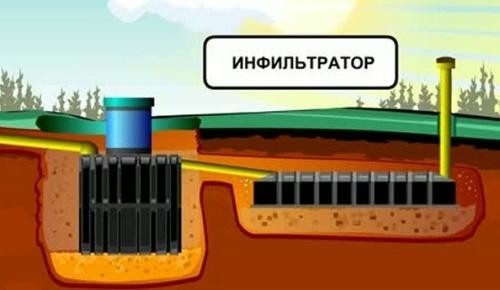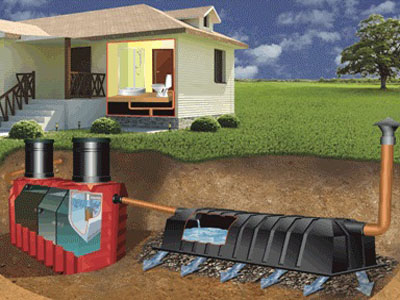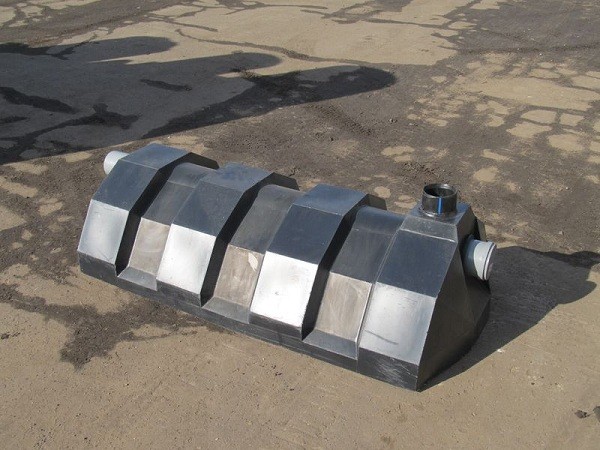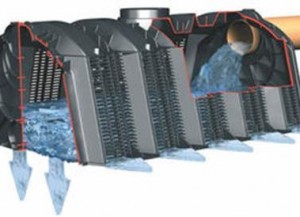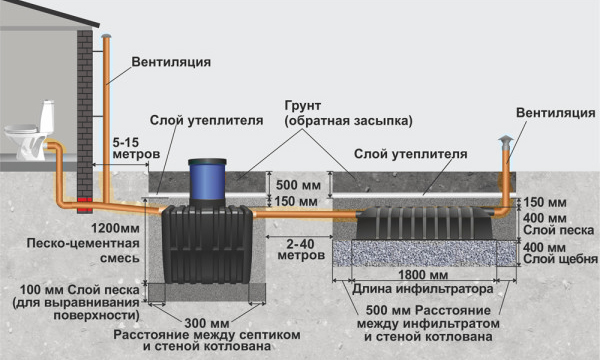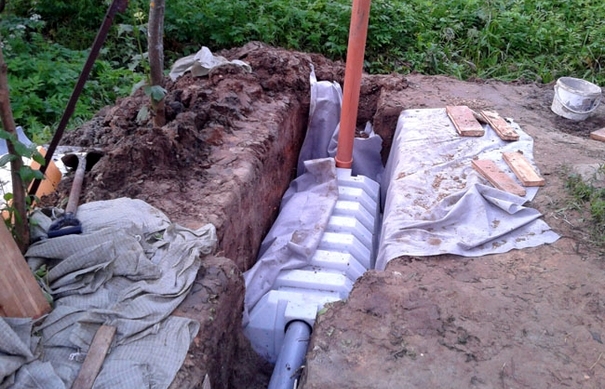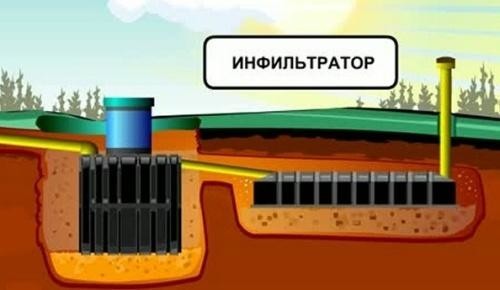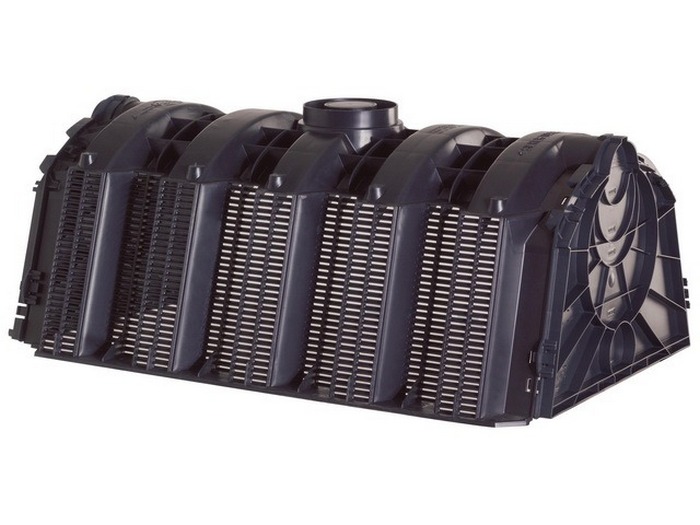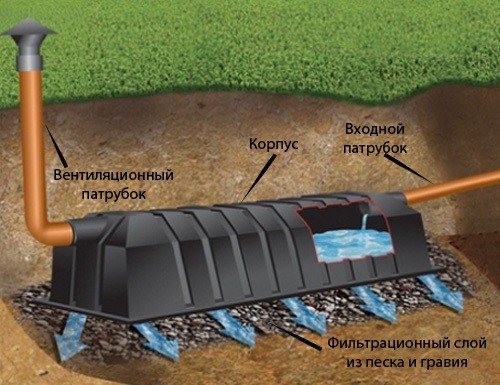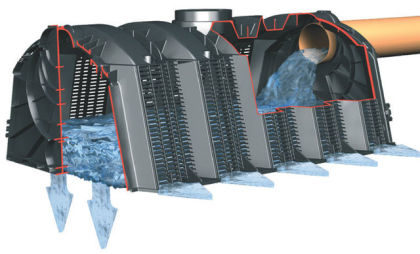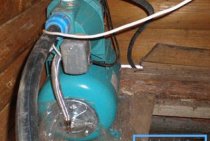Homemade infiltrators
It is impossible to make plastic wastewater treatment plants at home. Therefore, sheet metal is mainly used, the thickness of which is 2-4 mm.
In this case, preference should be given to stainless steel that can withstand the effects of sewage and groundwater:
- The volume of the infiltrator is determined based on the capacity of the septic tank and the estimated amount of effluent during salvo (one-time) discharges. Most often it is about 400 liters and above.
- The shape of the device should provide the ability to perceive significant loads from the overlying soil. Therefore, the infiltrator most often has a conical or trapezoidal configuration, while such a container does not have a bottom.
- In order to ensure sufficient strength of the product, they resort to assembling a two-layer case, the elements of which are separated from each other by rubber seals, which make it possible to reduce the loads that appear during operation.
- Two layers of the body are formed from sheet metal, during the manufacturing process it is necessary to combine both of these elements and check the identity of the configuration.
- The side walls and the main top cover of each layer are connected by welding.
- After both layers are ready, they are combined with each other, while rubber seals are laid between the surfaces, which will play the role of shock absorbers.
Drainage wells and infiltrators, in addition to the wastewater supply system, must also have ventilation devices that allow the gases formed during the cleaning process to be removed. The inlet and outlet (if it is necessary to connect several units in series) sewer pipes are mounted at the ends of the device in the upper part. The ventilation outlet is also installed at the top of the structure. All pipes are welded to the surfaces of the infiltrator body.
Purchase price
The cost varies depending on the manufacturer. In this category, 2 main groups can be distinguished - domestic and foreign.
The advantages of using infiltrators are obvious. A small and inexpensive design, together with a septic tank, can provide high-quality sewage treatment. At the same time, their maintenance is minimal, and the installation can be done independently.
Waste in aerobic septic tanks is cleaned by 70-75%. And this is not enough for water to be dumped into the ground or into a reservoir. In this case, a storage well or infiltrator for a septic tank is installed. The second option is considered the most preferable, as it has a low price and simple installation, and most importantly, it effectively cleans liquid waste. As a result, purified water can be reused for technical needs.
Infiltrator for septic tank Tank
The Triton-Plastic company is a manufacturer of well-known anaerobic septic tanks of the Tan and Triton brands. Thanks to its own production of plastic products, it was the first in the Russian market to produce infiltrators as an additional option for a septic tank.
At present, it is possible to purchase the Triton 400 infiltrator with the following technical parameters:
- dimensions - 1800 * 800 * 400;
- wall thickness - 10 mm;
- construction volume - 400 l;
- weight without connected pipes - 15 kg.
Depending on the model of the septic tank and the composition of the soil, a certain number of infiltrators is installed.
How to DIY
To make an infiltrator, you will need stainless steel 2-4 mm thick. The volume is determined depending on the size of the septic tank. The infiltrator is made in the form of a cone or a trapezoid. In order for it to withstand loads, the case must consist of two layers, with a gap between them of 1-1.5 cm.A rubber insulation will be laid in it, which plays the role of a shock absorber.
First, one body is welded, and then the second. In the process of work, you need to check that they are identical. Once both bodies are welded, they are combined. Holes for pipes are made on the side walls and as close to the top as possible. After that, the pipes are joined or welded. The ventilation pipe is made with a bend. From the device, it should move horizontally, and only then rise up.
The use of the infiltrator and the principle of its operation
An infiltrator is a collective name for soil treatment devices, they can be created from a variety of materials, but similar features of functioning are always preserved. The use of this device will be marked by a number of positive aspects:
- light weight combined with a high level of strength;
- the device is able to purify water regardless of the type of soil on which the septic tank is installed;
- one infiltrator is able to replace approximately 800 kilograms of gravel;
- the device withstands even the highest discharges of wastewater;
- able to replace about thirty-six meters of drainage pipes;
- easy to install and operate;
- prevents possible waterlogging of the territory;
- has a low price, which contributes to significant financial savings.
The infiltrator is used in cases where the septic tank is no longer able to purify water with high quality.
In such septic tanks as "Unilos" or "Bars mini" only 75% of the liquid is cleaned and in this case it is impossible to do without the above device. If the septic tank is more expensive - "Uponor", then there is no need to use the device. The principle of operation of this device is as follows:
- After the waters have been cleaned in the septic tank, they enter the infiltrator.
- Then, through a layer of gravel, the liquid is absorbed into the soil, this is necessary for its complete post-treatment.
- In order for the infiltrator to work efficiently and for a long time, it is necessary to monitor the degree of filling with water. The installation volume must exceed the maximum effluent emissions by at least 25%.
Selection of an infiltrator for a septic tank
It is worth noting that you can buy the first infiltrator that caught your eye, but there is a huge chance that it will not work properly. Therefore, for the correct selection of this device, several factors should be taken into account:

When choosing an infiltrator, it is necessary to take into account the technical parameters of the septic tank
- Technical parameters of the septic tank. The installation volume should be approximately three times higher than the performance of the septic tank. This is required for uninterrupted operation in the event of a sudden release of sewage or excess of their usual volume.
- Soil features. It should be calculated how quickly the liquid is absorbed into the soil - this is required in order for the device to properly perform its work. For example, sandy soil has a higher degree of moisture absorption than loam, so when installing infiltrators on sandy soil, they will need less.
- The main parameter of the post-treatment device is its volume and installation area.
Focusing on all the above features, you can choose the infiltrator that is really suitable for your land.
What it is
Compared to conventional cesspools, local treatment plants are much more practical, as they are able to purify water at a sufficiently high level. Infiltrators are devices that purify the water coming from the septic tank. They are most often made of plastic or any other material that can withstand significant loads and is not subject to corrosion.
The infiltrator consists of a body without a bottom so that water can freely pass through the filter layer. As well as the inlet pipe through which waste from the septic tank enters, and the outlet pipe for air supply.The case is additionally equipped with stiffeners so that the device does not sink under the pressure of the soil and does not burst under the pressure of the water from the inside.
Advantages of the infiltrator:
- the degree of wastewater treatment reaches 98%;
- low cost;
- does not need constant maintenance, including pumping out waste with a sewer.
Even with an anaerobic septic tank, the entire system will cost less than a deep cleaning station. Also, compared to aeration fields, these devices require less space. The walls are cleaned of waste with the help of water passing through the infiltrator, so it does not require maintenance.
For installation, you will need to allocate space, but even one person can carry out its installation, since the weight of the device is from 15 to 20 kg, depending on the volume.
Principle of operation
In the section of the body, the principle of operation of the infiltrator is visible. The sewage entering the housing is filtered by a layer of sand and gravel. In this way, the purification of liquid household waste occurs
After this procedure, sufficiently pure water enters the soil, but this happens underground, and harmful and foreign impurities settle in a limited volume. After the work of anaerobic bacteria, in the absence of oxygen, some organic substances remain in the septic tank.
In the infiltrator, a constant supply of fresh air is provided through the ventilation pipe. In the process of nitrification, or more simply, oxidation, the residues decompose completely.
Common models of infiltrators
Today, most often on the market you can find two types of infiltrators, such as Triton-400 and Polex-300.
The Triton-400 device has the following parameters:
- weight - fifteen kilograms;
- wall thickness - 10 millimeters;
- volume - four hundred liters;
- dimensions - 1800x800x400;
- price - from 4 to 5.5 thousand rubles;
- colors are dark.
The device "Polex-300" has the following parameters:
- weight - eleven kilograms;
- container volume - three hundred liters;
- dimensions - 1220x800x510 millimeters;
- price - from 4.5 thousand rubles;
- color — black, blue.
Many people prefer these devices due to the fact that they are easily fastened together both vertically and horizontally.
It is important to highlight that the number of devices that should be installed is completely dependent on the model, functionality of the septic tank and the type of soil. If the Tank 1 septic tank is installed on loam, then two Triton-400 devices should be used
If the installation was carried out on sandy or peat soil, then one infiltrator is enough.
Infiltrator for a septic tank device and principle of operation
As already written earlier, the function of the infiltrator is the final treatment of wastewater that has passed through. In fact, the device performs the same task as a filtration field or a drainage well, but more compact, cheaper and easier to install. The infiltrator is arranged as follows.
-
Frame
- Made of thick and durable plastic. It has a relatively elongated rectangular shape, in cross section it resembles a trapezoid. The body also plays the role of an infiltrator cover, equipped with stiffeners designed to strengthen the structure and protect it from pressure (earth from the outside and water from the inside). -
inlet pipe
- through it, water from the septic tank enters the infiltrator. -
Ventilation tube
- necessary for the flow of air into the infiltrator. Why this is needed will be discussed below. -
Rubble pillow
- the water entering the infiltrator passes the final post-treatment, seeping through this pillow into the ground.
Let us present the principle of operation of any infiltrator in the form of separate stages.
Stage 1.
Water flows from the septic tank into the infiltrator pipe.
Stage 2.
Through the pipe, it enters the inside of the infiltrator body.
Stage 3.
Upon contact with oxygen entering inside with air through ventilation, the process of oxidation and splitting of organic substances occurs, which were not previously screened out in the septic tank.
Stage 4.
Partially, the products of these reactions escape into the atmosphere through ventilation. The rest, together with water, fall into a layer of rubble.
Stage 5.
On a crushed stone pillow, the remnants of substances that pollute the drains are filtered out. Purified water goes into the ground without harming the environment and without poisoning nearby water bodies and wells.
Making an infiltrator with your own hands
For making an infiltrator
for septic tanks with your own hands you will need:
- sheet stainless steel 1.5-3mm thick (depending on the volume of the infiltrator);
- tool for working with metal (hammer and bar for bending);
- branch pipes (for inlet and ventilation inlets);
- welding machine;
- a set of fittings and rubber gaskets (for connecting to a septic tank and installing a ventilation tube).
The design of the filter will consist of an internal and external part. The inside of the structure is best made from a single sheet of metal, although this is a much more time consuming process. But it allows you to significantly reduce the number of welds. Due to this, the working part can be made more reliable and tight. Do not forget that the water coming from the septic tank should go exclusively down. We make the upper part of the infiltrator in such a way that after connecting them together, there remains gap 1.5–2 cm
. During assembly, rubber gaskets will be installed in it, which will serve as an additional shock absorber.
After assembling the structure, the joint, along the edge of the hulls, is welded by welding (preferably gas). At the ends of the assembled body, under the lid itself (do not forget - there is no bottom), we make holes, with a diameter for pre-prepared pipes, which we weld there. One of them will serve to connect to the septic tank, and the second - the ventilation pipe
Again, do not forget about the tightness of the seams - this is important
How does it work
The settled, clarified in the septic tank flows through the pipe from it to the infiltrator, as the septic tank is filled. In different designs, this happens in different ways: somewhere by gravity, somewhere with the help of a special pump.
The incoming effluents must be sufficiently cleaned, without large fractions, so as not to excessively clog the infiltrator and the crushed stone bedding, in which additional anaerobic self-cleaning of effluents will take place.
From the infiltrator, drains through the pillow go into the soil, where they are finally cleaned with the help of Mother Nature. For proper operation, it needs ventilation, for which an exhaust hood is placed in it.
Homemade infiltrators
It is impossible to make plastic wastewater treatment plants at home. Therefore, sheet metal is mainly used, the thickness of which is 2-4 mm.
In this case, preference should be given to stainless steel that can withstand the effects of sewage and groundwater:
- The volume of the infiltrator is determined based on the capacity of the septic tank and the estimated amount of effluent during salvo (one-time) discharges. Most often it is about 400 liters and above.
- The shape of the device should provide the ability to perceive significant loads from the overlying soil. Therefore, the infiltrator most often has a conical or trapezoidal configuration, while such a container does not have a bottom.
- In order to ensure sufficient strength of the product, they resort to assembling a two-layer case, the elements of which are separated from each other by rubber seals, which make it possible to reduce the loads that appear during operation.
- Two layers of the body are formed from sheet metal, during the manufacturing process it is necessary to combine both of these elements and check the identity of the configuration.
- The side walls and the main top cover of each layer are connected by welding.
- After both layers are ready, they are combined with each other, while rubber seals are laid between the surfaces, which will play the role of shock absorbers.
Drainage wells and infiltrators, in addition to the wastewater supply system, must also have ventilation devices that allow the gases formed during the cleaning process to be removed. The inlet and outlet (if it is necessary to connect several units in series) sewer pipes are mounted at the ends of the device in the upper part. The ventilation outlet is also installed at the top of the structure. All pipes are welded to the surfaces of the infiltrator body.
Types of infiltrators
Varieties of equipment for post-treatment are not too numerous. The main ones are:
- Prefabricated designs are flat, low tanks, in which the bottom side has a larger area than the top. At the same time, the water entering them can quickly seep into the soil over the entire surface of the filter layer.
- A homemade device may look like a well made of concrete rings. The bottom in it is covered with rubble. This design requires a large installation depth and is not suitable for a site with a high groundwater level.
- Infiltration tanks can also be made horizontal, repeating factory-type designs. For their manufacture, thick metal is used.
Choosing an infiltrator for a septic tank
Criteria for choosing an infiltrator
For the correct choice of an additional water treatment device, many factors must be taken into account:
- Technical characteristics of the septic tank, the total capacity of the infiltrators must exceed the performance of the septic tank by at least 3 times. This is necessary for stable operation in case of salvo discharge of wastewater and exceeding its usual volume;
- Soil properties, it is necessary to take into account at what approximate speed the water will be absorbed into the soil, so that the infiltrators can cope with the work. For example, in sandy soil, the rate of passage of moisture inside is higher than in loam, respectively, when installed in sandy soil, fewer infiltrators will be needed;
- The main parameters of the infiltrator are its volume and installation area.
A common model of the infiltrator is the Triton-400, which is most often installed together with the Tank septic tank. It has the following specifications:
- The mass of the container is 15 kg;
- Wall thickness - 10 mm;
- The total volume of the structure is 400 liters;
- Dimensions: 1800*800*400;
- The average cost is about 4000-5500 rubles.
Calculation of the number of infiltrators
The number of infiltrators that need to be installed depends on the model and capacity of the septic tank, as well as on the type of soil. So, for a Tank-1 septic tank installed in clay soil, 2 Triton-400 infiltrators are needed, and when installing the same septic tank in sand or peat, only one additional wastewater treatment device is needed.
The Polex-300 infiltrator is also on the market, its cost is about 4500 rubles, the device has the following technical characteristics:
- Infiltrator dimensions: 1220*800*510 mm;
- Weight - 11 kg;
- The total volume of the tank is 300 liters;
- Maximum load up to 3.5 tons per sq. meter.
These after-treatment devices are easily interconnected both vertically and horizontally. And thanks to special integrated platforms in the infiltrator, the convenience of connecting pipes increases.
How to choose an infiltrator for a septic tank
The choice of an infiltrator for a septic tank is carried out according to the following criteria:
- type of soil on the site and its permeability;
- infiltrator volume;
- performance quality;
- dimensions and weight;
- price.
Now let's look at these criteria in more detail. Let's start with the type of soil and its degree of water permeability.This criterion does not directly apply to the design of infiltrators, but it is very important, as it affects the number of devices that need to be purchased. Sandy soils absorb and pass water well, so you don’t need too many infiltrators - on average, one or two products are enough for a family of 3-4 people. A completely different situation is observed in the area with clays and loams - water permeability indicators are low there, therefore, more infiltrators will be required for the effective operation of the entire treatment system. Soil classification and filtration coefficients for its various types can be found in the tables below.
Table. Classification of soils according to the degree of water permeability.
Table. Filtration coefficient indicators for various types of soil.
| Soil type | Filtration coefficient, kf, m/day. |
|---|---|
| Gravel | 100 to 200, depending on faction |
| Sand and gravel | 75 to 150 |
| Sand coarse-grained | 25 to 75 |
| Medium sand | 10 to 25 |
| Fine-grained sand | 2 to 10 |
| Peat slightly decomposed | 1 to 4.5 |
| Peat, strongly decomposed | 0.01 to 0.15 |
| sandy loam | 0.2 to 0.7 |
| Loam | 0.005 to 0.4 |
| Clay | Less than 0.005 |
The second most important criterion for choosing an infiltrator is the internal volume. The larger it is, the more productive the product.
When looking for or purchasing infiltrators, be sure to consider this characteristic. For areas with loam, the total volume of post-treatment devices should be three times the capacity of the septic tank, measured in liters per day.
In the photo - "Triton 400", one of the most popular models of infiltrators. Behind him is "
The durability of the infiltrator and its resistance to pressure from above, from the sides or from the inside directly depend on the value of the permissible load and the quality of workmanship.
When purchasing a post-treatment device, be sure to pay attention to the thickness of the plastic - it must be uniform. Also, when buying, look carefully at the case for defects and weaknesses.
The next criterion is size and weight. These characteristics directly determine how convenient the infiltrator will be in transportation, carrying and installation, as well as how large a pit needs to be dug to install the product.
And the last - the cost of the post-treatment device. Be especially careful with infiltrators that are sold at a greatly reduced price - this may be a marriage. If the cost of the product seems too high to you, ask the seller what qualities and distinctive advantages of the infiltrator determine it.
Principle of operation
A septic tank with an infiltrator works as follows:
- Waste water enters the septic tank. After that, the clarified waste flows through the outlet pipe into a pipe connected to the infiltrator.
- Once in the post-treatment device, the process of nitrification begins in the wastewater, or rather, organic substances are oxidized and decomposed. This whole process is started by the intake of air through the ventilation pipe of the infiltrator.
- The filtration layer under the device cleans the water. As a result, sewage, cleaned by 70% in a septic tank, is finally filtered.
If the maximum one-time discharge is greater than the volume of one infiltrator, then several of them are installed.
So, if one is completely filled, then wastewater flows through the overflow pipe into the next, and so on.
Why you need an infiltrator
The infiltrator is necessary for the complete purification of water and its output to the soil, due to its design, the device carries out the output of water to a shallow depth of the soil. Advantages of this cleaner:
An infiltrator is needed when the water are not cleaned by the septic tank of sufficient quality
, for example, only by 75% (in such septic tanks as Unilos, Triton mini, Bars mini).When installing treatment devices that can handle 98% or more wastewater treatment (for example, Uponor), an infiltrator will not be required. This device works according to the following principle:
- Water after cleaning in the septic tank enters the infiltrator tank;
- Then they are absorbed into the soil, through a layer of rubble, which is necessary for the complete purification of water;
- For proper and stable operation, the infiltrator should not be completely filled with water, its volume should exceed peak discharges by at least 25%.
Septic Tank
For you need to prepare the following materials and tools:
- sheet stainless steel, the thickness of which is 2-3 mm;
- a wooden block, a hammer, which are necessary to ensure the safety of the metal sheet when it is bent;
- pliers;
- welding machine;
- rubber gaskets, which should be 2 mm thicker than the passage (their thickness is 1.2-1.7 cm);
- metal pipes - 2 pcs.;
- ventilation pipe with a special cone-cap.
Drawing of a septic tank "Tank".
The process of installing a septic tank "Tank" is as follows:
- first you need to calculate the volume that the septic tank will have, usually it should not be less than 400 liters;
- then an inner layer of steel is made, the joints of which must be slightly rounded to withstand pressure;
- the outer layer is made in such a way that the cover has a conical shape, this reduces the load on the entire structure;
- rubber gaskets are installed between the walls, acting as shock absorbers;
- after that, the frame is welded;
- the air pipe for the "Tank" is made in such a way that it moves a little to the side, after which it rises sharply up to a level of up to 30 cm above the ground. Such a pipe is subsequently covered with a cone so that debris does not get into it.
The infiltrator will stand somewhat to the side, it will be necessary to bring a pipe to it.
Start of work on the installation of the infiltrator
Pit preparation
Its dimensions depend on your design, but with a margin of several tens of centimeters (at least forty). This space will subsequently be covered with sand. The depth should be such that the outlet pipe of the septic tank and the infiltrator inlet coincide. At this depth, it is worth making a mark, so that later, after filling the gravel and sand, you do not miss. After that, we deepen the pit even more to fill the filter layer of crushed stone. The depth of penetration will depend on the absorbing properties of the soil, but should not be less than 40 cm
. It makes sense to make this recess expanding downwards to increase the filter area and absorbent surface.
Laying of the geofilter layer
After the work, the bottom and walls of the pit are lined with geotextiles. Later, its edges will wrap around the body of the infiltrator. This will keep the geofilter intact and prevent unfiltered runoff from seeping into the soil. The next step is to fill in a mixture of crushed stone and sand to a level pre-set mark. You can add a few centimeters more, as the infiltrator will sag a little under its own weight. The filter surface is carefully leveled, ideally on a “level”.
Installation of an infiltrator for a septic tank and completion of the robot
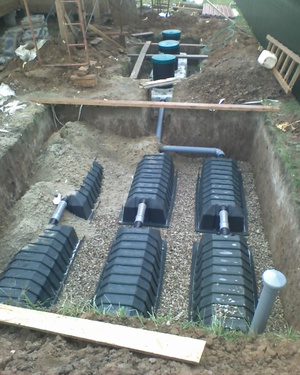
. To connect to the septic tank and ventilation, pre-stocked rubber gaskets are used. To increase the reliability of connections, sealants can also be used. After checking the tightness of the joints, as mentioned earlier, the structure is wrapped with geotextiles.
The next step is to fill the space remaining between the infiltrator and the walls of the pit with sand to the level of the lid.Filling should be done evenly. Do not allow voids or open seams (they bear the main load). Then carefully tamp. Fill the rest of the pit with soil level with the ground. The one that you dug out of the pit is quite suitable. The system is ready to go. If all work has been completed carefully and carefully
- there will be no complications.
Separately, it is worth adding that manufacturers recommend installing an infiltrator or their systems, simultaneously with a septic tank. This will somewhat simplify the planning and installation of the drainage system. But in most cases, this approach can be applied when the process of building a future house has just begun, and you have the opportunity to allocate a separate place for installation. However, there is no problem in retrofitting the sewage system if the construction work has already been completed. Considering, of course, the recommendations given above.
Septic tanks of low and medium price categories do not fully filter sewage - in this form, it is impossible to drain the purified liquid into the ground or ditch, additional treatment is required. The traditional methods are also the filtration field - objects that require a lot of time and effort for the arrangement (costs are comparable to those for installing a septic tank). But modern industry has a good solution to this problem - infiltrators for septic tanks. These post-treatment devices will be discussed in this article.
Infiltrator
What is an infiltrator for?
Private households, as a rule, are equipped with a sewer system that involves the discharge of domestic wastewater either into innovative local systems of deep biological treatment, or into more traditional storage or anaerobic (bacterial) septic tanks. Deep cleaning structures remove water that is suitable for household use, such as irrigation.
But what if there is nothing to water or if there is much more treated wastewater than is necessary for economic needs? It is possible to dispose of such water into the ground with the help of an infiltrator. Here it becomes a kind of replacement for the so-called filtering fields, but at the same time it takes up significantly less space.
In turn, anaerobic septic tanks do not allow reaching the same level of water purity as more modern counterparts. And it is in the infiltrator that 50-60% clarified wastewater can undergo post-treatment for their subsequent safe disposal into the ground.
Types of infiltrators
Varieties of equipment for post-treatment are not too numerous. The main ones are:
- Prefabricated designs are flat, low tanks, in which the bottom side has a larger area than the top. At the same time, the water entering them can quickly seep into the soil over the entire surface of the filter layer.
- A homemade device may look like a well made of concrete rings. The bottom in it is covered with rubble. This design requires a large installation depth and is not suitable for a site with a high groundwater level.
- Infiltration tanks can also be made horizontal, repeating factory-type designs. For their manufacture, thick metal is used.
